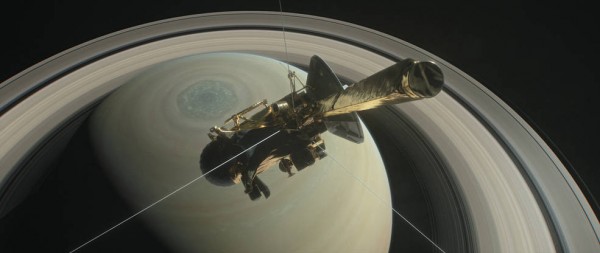By Ana Verayo, | April 06, 2017

This illustration shows NASA’s Cassini spacecraft above Saturn's northern hemisphere prior to one of its 22 grand finale dives. (NASA/JPL-Caltech)
NASA's Saturn spacecraft Cassini will soon complete its final orbit around the majestic ringed planet and will make its "Grand Finale" on April 26, Wednesday. This last maneuver involves completing dives within Saturn's atmosphere and in between its rings.
According to Thomas Zurbuchen of NASA's Science Mission Directorate in Washington, no spacecraft has ever gone to this distinct region in the solar system. Cassini's daring final orbits has provided crucial insight into how gas giants and giant planets form and evolve. This also means shedding more light into planetary giants in other systems across the galaxy and beyond.
Like Us on Facebook
In the past few weeks, the spacecraft has been diving into the outer rings of Saturn during an important scientific phase of the mission known as ring grazing orbits. This provided new high-resolution images of Saturn's rings providing unprecedented views of it along with the planet's strange moons. Moons Enceladus and Titan apparently possess global oceans, liquid methane seas and hydrothermal activity within.
As Cassini plunges into Saturn's cloud tops around 1,012 above them, the final orbits will mostly consist of exploring the ring gap between the gas giant's atmosphere. Then, the probe will make its final death dive into Saturn's atmosphere as it records and beams back precious data back to Earth.
Mission scientists are planning to execute the final commands for Cassini's last maneuver. During its last phase of the mission, the spacecraft will observe and study the atmospheric composition of Saturn along with its main and inner rings.
"Based on our model's predictions, this ring gap will be clear of any large particles that can cause any damage during the last dives between the rings and the clouds. During the first pass, we will be cautious to use Cassini's large antenna, and then we will determine whether or not it is safe to expose the rest of the onboard scientific instruments when Cassini enters deep into the atmosphere," Cassini project manager Earl Maize of NASA's Jet Propulsion Laboratory said.
Scientists are aware of the risks involved during this last stage of the Cassini mission, but researchers are determined to study and sample Saturn's thick atmospheric layers.
-
Use of Coronavirus Pandemic Drones Raises Privacy Concerns: Drones Spread Fear, Local Officials Say

-
Coronavirus Hampers The Delivery Of Lockheed Martin F-35 Stealth Fighters For 2020

-
Instagram Speeds Up Plans to Add Account Memorialization Feature Due to COVID-19 Deaths

-
NASA: Perseverance Plans to Bring 'Mars Rock' to Earth in 2031

-
600 Dead And 3,000 In The Hospital as Iranians Believed Drinking High-Concentrations of Alcohol Can Cure The Coronavirus

-
600 Dead And 3,000 In The Hospital as Iranians Believed Drinking High-Concentrations of Alcohol Can Cure The Coronavirus

-
COVID-19: Doctors, Nurses Use Virtual Reality to Learn New Skills in Treating Coronavirus Patients








